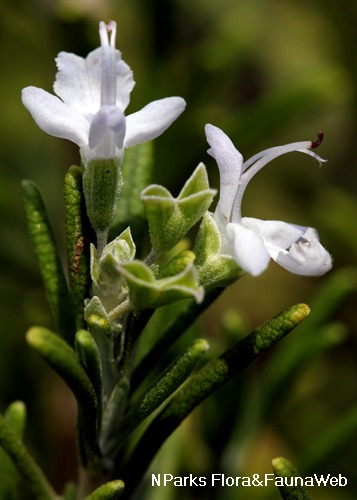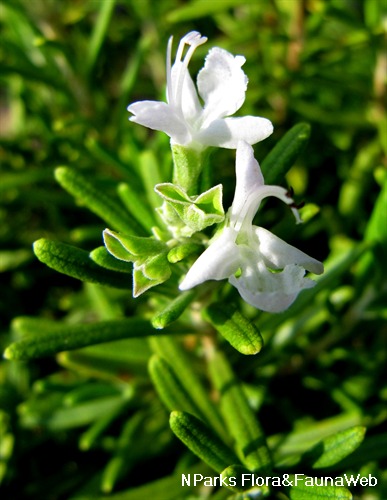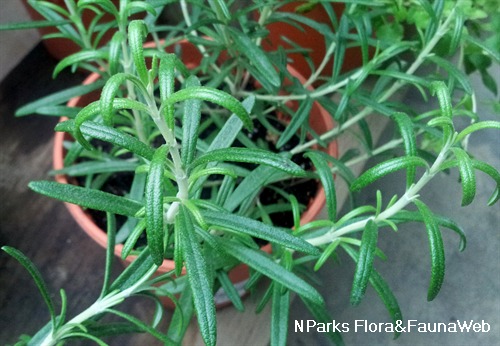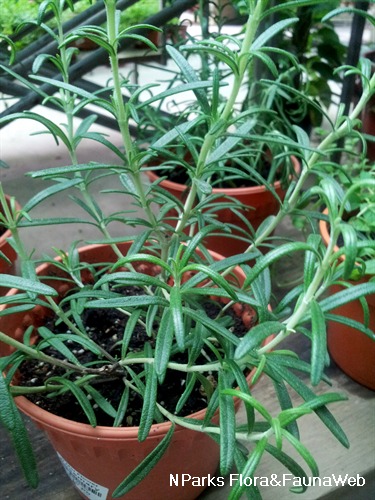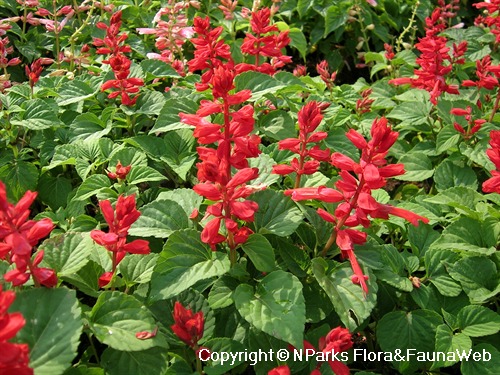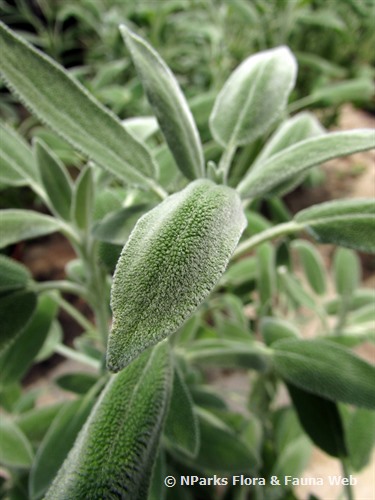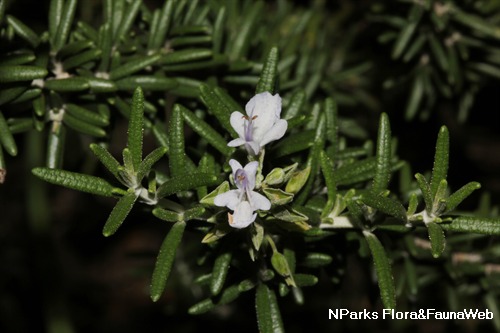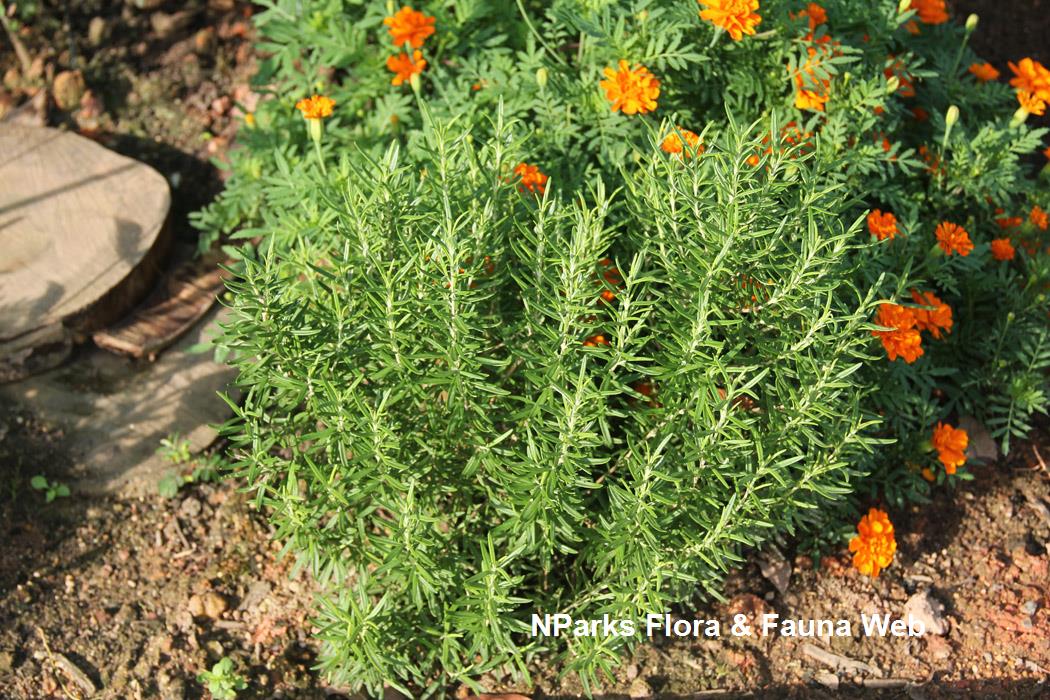
Back
Salvia rosmarinus Schleid.
| Family Name: | Lamiaceae (Labiatae) |
| Synonyms: | Rosmarinus officinalis |
| Common Name: | Rosemary, 迷迭香 |
Name
Classifications and Characteristics
| Plant Division | Angiosperms (Flowering Seed Plants) (Dicotyledon) |
|---|---|
| Plant Growth Form | Shrub |
| Lifespan (in Singapore) | Perennial |
| Maximum Height | 1.5 m to 2 m |
Biogeography
| Native Distribution | Mediterranean |
|---|---|
| Native Habitat | Terrestrial |
| Preferred Climate Zone | Mediterranean |
| Local Conservation Status | Non-native (Horticultural / Cultivated Only) |
Description and Ethnobotany
| Growth Form | Perennial shrub up to 2m tall and 1.5m in spread, it has an upright and rounded growth form. |
|---|---|
| Foliage | The simple, stalkless to shortly-stalked, needle-like leaves are strongly aromatic, 1 - 2.5cm long and 1 - 2mm wide. |
| Stems | New stems are herbaceous, while older stems become woody over time. |
| Flowers | The flowers are borne in the leaf axils along the upper parts of new stems. The flowers are whitish, bluish, or bluish purple flowers and are 2-lipped and tubular, the lower petal being three-lobed while the upper petal is two-lobed. |
| Fruit | The fruit is composed of 4 small, 1-seeded segments known as nutlets. |
| Cultivation | This species requires a well-draining, lightweight soil and does not do well in waterlogged soil. It is best grown under full sun. |
| Ethnobotanical Uses | Edible Plant Parts : Edible Leaves Food (Herb or Spice): The leaves are used as a culinary herb and are used as dressing for dishes or used to flavour smoked or roasted meat. The leaves have a bitter, astringent taste. Others: Pregnant or breast-feeding women should avoid taking the essential oil of rosemary. |
Landscaping Features
| Desirable Plant Features | Fragrant (Foliage) |
|---|---|
| Landscape Uses | Topiary, Container Planting |
| Thematic Landscaping | Fragrant / Aromatherapy Garden, Economic Garden |
Plant Care and Propagation
| Light Preference | Full Sun |
|---|---|
| Water Preference | Little Water |
| Rootzone Tolerance | Easy to Grow, Drought Tolerant, Disease / Pest Resistant, Well-Drained Soils |
| Maintenance Requirements | Low |
| Propagation Method | Stem Cutting, Root Cutting |
| Propagation Method Remarks | Propagation by ground-layering is possible by fixing the stem to the ground until it forms roots and then, separating the rooted stem from the parent plant. Propagation by seed is not recommended due to the slow germination rate. |
Foliar
| Foliage Retention | Evergreen |
|---|---|
| Mature Foliage Colour(s) | Green |
| Mature Foliage Texture(s) | Rough |
| Foliar Type | Simple / Unifoliate |
| Foliar Arrangement Along Stem | Spiral |
| Foliar Attachment to Stem | Petiolate |
| Foliar Shape(s) | Non-Palm Foliage (Linear) |
| Foliar Venation | Pinnate / Net |
| Foliar Margin | Entire |
| Foliar Apex - Tip | Rounded |
Floral (Angiosperm)
| Flower & Plant Sexuality | Bisexual Flowers |
| Flower Colour(s) | White, Blue |
|---|---|
| Flower Texture(s) | Smooth |
| Flower Colour(s) Remarks | Bluish Purple |
References
| References | Lawton, B.P. (2002). Mints: A Family of Herbs and Ornamentals. USA: Timber Press. 239 pp. |
|---|
Image Repository
Others
| Master ID | 17114 |
|---|---|
| Species ID | 3338 |
| Flora Disclaimer | The information in this website has been compiled from reliable sources, such as reference works on medicinal plants. It is not a substitute for medical advice or treatment and NParks does not purport to provide any medical advice. Readers should always consult his/her physician before using or consuming a plant for medicinal purposes. |



